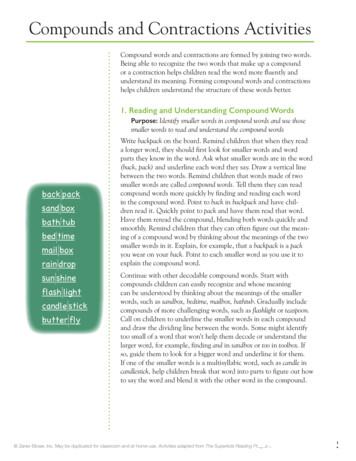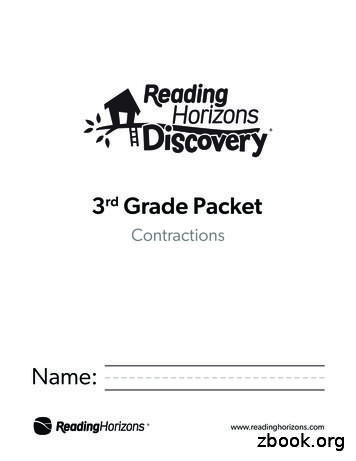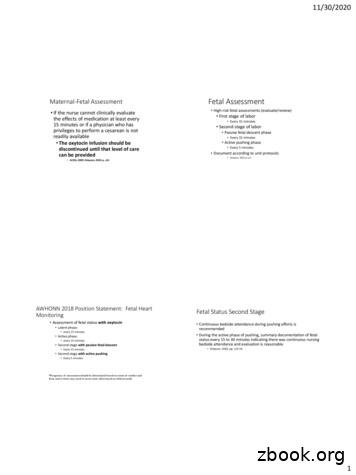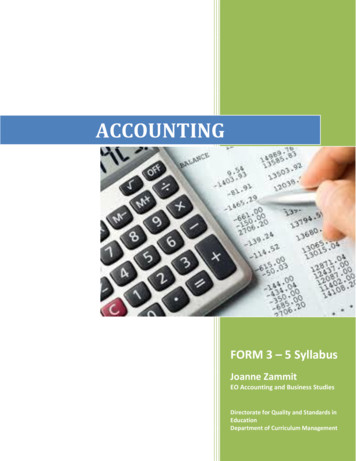Compounds And Contractions Activities - Zaner-Bloser
Compounds and Contractions ActivitiesCompound words and contractions are formed by joining two words.Being able to recognize the two words that make up a compoundor a contraction helps children read the word more fluently andunderstand its meaning. Forming compound words and contractionshelps children understand the structure of these words better.1. Reading and Understanding Compound WordsPurpose: Identify smaller words in compound words and use thosesmaller words to read and understand the compound wordsback packsand boxbath tubbed timemail boxrain dropsun shineflash lightcandle stickbutter flyWrite backpack on the board. Remind children that when they reada longer word, they should first look for smaller words and wordparts they know in the word. Ask what smaller words are in the word(back, pack) and underline each word they say. Draw a vertical linebetween the two words. Remind children that words made of twosmaller words are called compound words. Tell them they can readcompound words more quickly by finding and reading each wordin the compound word. Point to back in backpack and have children read it. Quickly point to pack and have them read that word.Have them reread the compound, blending both words quickly andsmoothly. Remind children that they can often figure out the meaning of a compound word by thinking about the meanings of the twosmaller words in it. Explain, for example, that a backpack is a packyou wear on your back. Point to each smaller word as you use it toexplain the compound word.Continue with other decodable compound words. Start withcompounds children can easily recognize and whose meaningcan be understood by thinking about the meanings of the smallerwords, such as sandbox, bedtime, mailbox, bathtub. Gradually includecompounds of more challenging words, such as flashlight or teaspoon.Call on children to underline the smaller words in each compoundand draw the dividing line between the words. Some might identifytoo small of a word that won’t help them decode or understand thelarger word, for example, finding and in sandbox or too in toolbox. Ifso, guide them to look for a bigger word and underline it for them.If one of the smaller words is a multisyllabic word, such as candle incandlestick, help children break that word into parts to figure out howto say the word and blend it with the other word in the compound. Zaner-Bloser, Inc. May be duplicated for classroom and at-home use. Activities adapted from The Superkids Reading Program.1
Give examples of compound words whose meanings can’t be fullyunderstood using the meanings of the smaller words, such asbutterfly, flapjack, honeymoon, brainstorm. Explain that sometimes thesmaller words in a compound word aren’t helpful in figuring out thecompound’s meaning. Point out that if they come across a compoundword like that as they read, they should use other words in thesentence or nearby pictures to figure out the compound’s meaning.Write compound words on paper strips. Make a foldbetween the two smaller words in each compound word so the twowords are back-to-back. Show the first word. Have children read it.Do the same for the second word. Then unfold the strip and havechildren read the compound word, orally blending the two wordsquickly and smoothly. Or cut the compound words apart, showthe two words with space between them, and have children readeach word. Push the two words together and have them read thecompound word.Variation 1Make sets of word cards that show related compoundwords. One of the smaller words in each compound should be thesame for all the words in a set—for example, compound wordsformed with sun, snow, bath, ball, home, sea, foot, hair, fire, eye, and soon. Mix all the cards. Have children take turns reading the wordsand grouping the compounds with the same smaller word in them.Have them tell how the words in a group are alike and the meaningsof the compound words.Variation 2TIP: Understanding closed, open, and hyphenated compoundwords Closed, or solid, compounds are written as single words,cup cakecupcakesunsetsunburnsuch as backpack. An open compound is spelled as two or moreseparate words, such as post office, high school, living room,ice cream, no one, hot dog. The words in hyphenated compoundsare separated by hyphens, as in merry-go-round, six-year-old,brother-in-law. With frequent use, open and hyphenated compounds tend to become closed (on line to on-line to online). Whenchoosing examples, use closed compounds. If children write anopen or hyphenated compound as a single word, it isn’t importantto correct the spelling at this age unless the word is frequentlyused, such as no one. Zaner-Bloser, Inc. May be duplicated for classroom and at-home use. Activities adapted from The Superkids Reading Program.2
2. Forming Compound WordsPurpose: Join smaller words to form compound wordsMaterials: Index cardssea gullshellbedtimeOn separate index cards, write words that can be joined to formcompound words children can read. Place several of these cardsfaceup on a table. Then say a compound word that uses two ofthe words shown and give a context sentence for the compound.Ask children which two words should be put together to make thecompound word you said. Join those two words and have childrenread the compound word. Point out that when two words are joinedin a compound, the spelling of the smaller words usually doesn’tchange. Then say other compound words, give context sentences forthem, and have children take turns using the word cards to form thecompounds you said. Give children practice forming sets of relatedwords, such as seashell, seashore, seaweed, seagull, seafood. For spellingreinforcement, have them make a list of the words they formed.Give clues about the meaning of a compound thatincludes words children can spell. Say, for example, “It’s a little cakebaked in a cup.” Have everyone say the answer on your signal. Callon a child to write the word on the board.Variation 1cupcakepanWrite compound words on index cards. Cut them apart,separating the two words that make up each compound. Mix thecards and distribute them to children. Have a child show and readhis word. Tell the others that if they have a word that can be joinedwith this word to make a compound word, they should hold up thatword. Ask each of these children to read their word and say thecompound word it makes when joined with the first child’s word.Discuss whether the compound word is a real word and if so, what itmeans. The child who said the compound word can write it on theboard. Continue until all the words have been used at least once.Variation 2 Zaner-Bloser, Inc. May be duplicated for classroom and at-home use. Activities adapted from The Superkids Reading Program.3
3. Forming and Reading ContractionsPurpose: Join two words to form contractions and read thecontractions aloudMaterials: Index cardsOn the board, write is not and use the words in a context sentence.Repeat the sentence, saying “isn’t” in place of “is not.” Say “isn’t”again and write the contraction under is not. Remind children thatisn’t is called a contraction, and contractions are shorter ways of sayingor writing two words. Tell them that is not and isn’t have the samemeaning. Have children compare is not and isn’t. Point out that in thecontraction, the two words are joined and an apostrophe takes theplace of letter o in not. Cross out the o in not and place an apostropheabove it.Remind children they can read contractions by saying the smallerword at the beginning of the contraction and then saying the soundsfor the remaining letters. Cover n’t in isn’t and have children read theword is. Then uncover n’t and have children say the sounds for theseletters. (/nt/) Point out that the apostrophe doesn’t stand for a sound.Repeat these steps to have children form and read thesecontractions: hasn’t, haven’t, aren’t, didn’t, wasn’t, weren’t, couldn’t,wouldn’t. Point out the spelling pattern that occurs when formingthese contractions—the first word stays as is and the o in not isreplaced with an apostrophe.Help children form and read the trickers don’t, can’t, won’t. Point outthat don’t follows the same spelling pattern as the other contractionsmade with not, but the word do changes to /dō/. Have children readdon’t with you. For can’t and won’t, point out that the spelling ofcan and will changes when these words are joined with not. Havechildren read can’t and won’t with you.Use this same process to review contractions made from a personalpronoun and a verb. Show how different pronouns can be added tothe same verb, so children see the same letter(s) are dropped fromthe verb each time and replaced by an apostrophe. For example, joinit, he, she with is. Point out that the i in the verb is is replaced with anapostrophe each time. For I’m, explain that I is the only pronoun amjoins with.is not ’isn’t’has not hasn’t’was not wasn’t’are not aren’t’could not couldn’t’ were not’have not weren’thaven’t’did not didn’tdo notdon’t’it isit’s Zaner-Bloser, Inc. May be duplicated for classroom and at-home use. Activities adapted from The Superkids Reading Program.’would not wouldn’tcannotcan’t’he ishe’swill notwon’t’she isshe’s4
isn’tis notwon’twill notHere are some other ways to reinforce children’s understanding ofcontractions: Create two sets of word cards: one set shows contractions and theother set shows pairs of words that correspond to the contractions.Mix the cards and spread them faceup on a table. Have childrentake turns matching each contraction with the pair of words itrepresents, reading the contraction, and using it in a sentence. Using the same set of word cards as above, play ContractionConcentration. Spread the cards with contractions facedown inone area of a table. Spread the cards with the corresponding pairsof words facedown in another area. Have children take turnschoosing a card from each set and telling if the contraction and thepair of words match. If they do, the child reads the contraction andkeeps the pair. If not, the child returns the cards facedown to theiroriginal places. Play until all cards have been matched. Give children decodable sentences that include pairs of words thatcan be joined to form taught contractions. Tell children to look forpairs of words they can replace with contractions. Have them crossout those pairs of words and write the contraction for the word pairabove the crossed out words. Once children know both you’re and your, write the words on theboard far apart. Have them read the words. Point out that thesewords sound the same, but they have different meanings andspellings. Review the meaning of each word. Say context sentencesthat use either you’re or your. After each sentence, have childrenpoint to the word that makes sense in the sentence you said.Repeat for they’re, there, their. Give children practice distinguishing between taught contractionsand look-alike words, such as she’ll and shell, I’ll and ill, we’re andwere, we’ll and well. Write the words on index cards and havechildren read each word as you say it. Remind them to look for theapostrophe in the contractions. Zaner-Bloser, Inc. May be duplicated for classroom and at-home use. Activities adapted from The Superkids Reading Program.888.378.9258 zaner-bloser.com5R1689J 04.20
contractions: hasn’t, haven’t, aren’t, didn’t, wasn’t, weren’t, couldn’t, wouldn’t. Point out the spelling pattern that occurs when forming these contractions—the first word stays as is and the o in not is replaced with an apostrophe. Help children
Choose two contractions from the word bank, and write the words that are used to form each one. 7. Write two contractions from the word bank that are formed using the word is. 8. Write a sentence using a contraction from the word bank. 9. Write a sentence using a possessive from the word bank. (Form B) Spelling LESSON WEEK 5: Contractions and .
contractions considerably differ from concentric or isometric contractions (Duchateau and Baudry,2014). Differences are detected on the level of the contracting muscle as well as on the cortical level. Most studies indicate a reduced central activation (evidenced by a lower EMG amplitude) during maximal eccentric contractions than maximal .
More than 5 contractions in 10 minutes averaged over 30 minutes Contractions lasting 2 minutes or more Insufficient return of uterine resting tone between contractions via palpation or intraamniotic pressure above 25 mmHg between contractions via IUPC Simpson, 2020, p. s 23; s37 The tracing continued like this for 30 minutes .
Naming Compounds Review Naming Ionic, Covalent, and Polyatomic compounds Compounds Compounds: pure substances containing atoms of more than one type of element joined together by chemical bonds (electrical attractions that hold atoms or ions together) Naming Chart – to help you out as we go through this process Naming Compounds
Aromaticity in Benzenoid Compounds Benzenoid aromatic compounds are the organic molecular species either with isolated benzene rings or with multiple benzene rings which fused to form a more complex structure. Therefore, these compounds can further be classified into monocyclic aromatic compounds and polycyclic aromatic compounds.
Chapter 2-3 Carbon Compounds. A. Organic compounds- originally thought to be compounds produced by living organism, now it refers to compounds containing carbon. 6 C Carbon 12.011. a. Carbon atoms have 4 valence electrons 1. The carbon atom is unique and carbon compounds are
All the compounds that exist on Earth are built from elements 118 elements are on the periodic table; only 80 commonly form compounds 10 million known compounds; billions of possible compounds Figure 2.22: Hydrogen and carbon alone can be combined in millions of ways to make compounds with very different properties.
Edexcel IGCSE Accounting Pg 10 1.3 The accounting equation learn a simple Statement oflist examples of Refer to Sec Syllabus assets and Financial Position(horizontal/T The Principles of liabilities style) which explains the basic Double-Entry accounting equationclassification of . items as assets calculate the value of assets, Go For Accounting Pg and liabilities liabilities and capital using .























